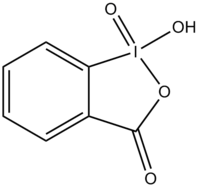IBX acid
 |
|||
|
|
|||
| Names | |||
|---|---|---|---|
| Other names
1-hydroxy-1λ5,2-benziodoxol-1,3-dione
1-hydroxy-1λ3,2-benziodoxol-3(1H)-one 1-oxide |
|||
| Identifiers | |||
|
61717-82-6 |
|||
| 3D model (Jmol) |
Interactive image Interactive image |
||
| ChEBI |
CHEBI:52701 |
||
| ChEMBL |
ChEMBL118857 |
||
| ChemSpider |
300947 |
||
| ECHA InfoCard | 100.157.592 | ||
| PubChem | 339496 | ||
|
|||
|
|||
| Properties | |||
| C7H5IO4 | |||
| Molar mass | 280.02 g/mol | ||
| Melting point | 233 °C (decomposes) | ||
| Hazards | |||
| R-phrases | R22 R34 R44 | ||
|
Except where otherwise noted, data are given for materials in their standard state (at 25 °C [77 °F], 100 kPa).
|
|||
|
|
|||
| Infobox references | |||
IBX or 2-iodoxybenzoic acid is an organic compound used in organic synthesis as an oxidizing agent. This periodinane is especially suited to oxidize alcohols to aldehydes. IBX is prepared from 2-iodobenzoic acid, potassium bromate and sulfuric acid. Frigerio and co-workers have also demonstrated, in 1999 that potassium bromate may be replaced by commercially available Oxone. One of the main drawbacks of IBX is its limited solubility; IBX is insoluble in many common organic solvents. In the past, it was believed that IBX was shock sensitive, but it was later proposed that samples of IBX were shock sensitive due to the residual potassium bromate left from its preparation. Commercial IBX is stabilized by carboxylic acids such as benzoic acid and isophthalic acid.
The reaction mechanism for an oxidation of an alcohol to an aldehyde according to the so-called hypervalent twisting mechanism involves a ligand exchange reaction replacing the hydroxyl group by the alcohol followed by a twist and an elimination reaction. The twist is a requirement because the iodine to oxygen double bond is oriented out of plane with the alkoxy group and the concerted elimination would not be able to take place. This twist reaction is a rearrangement in which the oxygen atom is moved into a proper plane for a 5 membered cyclic transition state in the elimination reaction and is calculated by Computational chemistry to be the rate-determining step in the oxidation. The twist mechanism also explains why oxidation is faster for larger alcohols than for small alcohols. The twist is driven forward by the steric hindrance that exists between the ortho hydrogen atom and the protons from the alkoxy group and larger alkoxy groups create larger steric repulsion. The same computation predicts a much faster reacting IBX derivative with a 100 fold reaction rate when this ortho hydrogen atom is replaced by a methyl group thus facilitating the twist until the elimination reaction takes prevalence as the rate determining step.
...
Wikipedia


